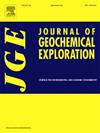保加利亚东北部和土耳其西北部最大显生宙锰矿床的年龄和成因:40Ar/39Ar和U/Pb年龄的推断
IF 3.3
2区 地球科学
Q1 GEOCHEMISTRY & GEOPHYSICS
引用次数: 0
摘要
黑海沿岸早渐新世锰矿(600 × 106吨)是世界第二大锰富集区。人们提出了各种各样的假说来解释这些矿床的成因。然而,很少能解释锰矿床的所有主要特征,特别是:1)同代性和短沉积时间;2)覆盖面积大;3)大量金属(Mn、Fe、P和Si)的来源;4)金属的沉淀和富集机理。以往的假设大多认为锰的来源是当地的结晶岩,忽视或误解了火山物质的参与。在这里,我们提出了一个火山衍生模型,该模型来源于保加利亚Rhodope地块的33.2±0.1 Ma超级火山喷发,该火山喷发覆盖了中欧、南欧和东欧的大片地区。该模型基于位于黑海西岸的两个锰矿床的火山物质的放射性同位素年龄数据。我们的模型表明,Mn(以及其他金属,Fe, P, Si)已被大量喷发的灰尘和气溶胶携带吸收的可溶性氟化物,氯化物和硫酸盐金属运输。气体和气溶胶快速溶解到受限的或浅层的傍泰提斯海盆中,产生了缺氧-缺氧条件,这反过来又促进了锰的高浓度和沉积。矿床分带的最终构造是火山影响结束后正常的海氧化还原-分层恢复的结果。本文章由计算机程序翻译,如有差异,请以英文原文为准。
Age and genesis of the largest Phanerozoic Mn deposits in the Paratethys: Inferences from 40Ar/39Ar and U/Pb ages in NE Bulgaria and NW Turkey
The early Oligocene manganese (Mn) deposits around the Black Sea represent the second largest accumulation of Mn in the world (600 × 106 tons). Various hypotheses have been offered to explain the genesis of these deposits. However, very few can explain all the major characteristics of the Mn deposits, in particular: 1) their contemporaneity and short depositional time; 2) vast covered territory; 3) the source of the great volume of metals (Mn, Fe, P and Si) and 4) the mechanisms of metal precipitation and concentration. Most of the former hypotheses assume the source for the Mn is the local crystalline rocks, ignoring or misinterpreting the involvement of volcanic material. Here, we propose a volcanic-derived model sourced from a 33.2 ± 0.1 Ma supereruption from the Rhodope Massif, Bulgaria, which covers large areas of the Central, Southern and Eastern Europe with ash. The model is based on radioisotopic age data of the volcanic material from two of the Mn deposits, located on the western shore of the Black Sea. Our model implies that the Mn (along with other metals, Fe, P, Si) have been transported by the large amount of erupted dust and aerosols with absorbed soluble fluoride, chloride, and sulfate metals. The fast dissolution of gases and aerosols into restricted or shallow Paratethys sea basins produced anoxic-euxinic conditions, which in turn promoted high concentration and deposition of the Mn. Final structuring of the zonation of the deposits was the result of the restoration of the normal sea redox-stratification after the end of the volcanic influence.
求助全文
通过发布文献求助,成功后即可免费获取论文全文。
去求助
来源期刊

Journal of Geochemical Exploration
地学-地球化学与地球物理
CiteScore
7.40
自引率
7.70%
发文量
148
审稿时长
8.1 months
期刊介绍:
Journal of Geochemical Exploration is mostly dedicated to publication of original studies in exploration and environmental geochemistry and related topics.
Contributions considered of prevalent interest for the journal include researches based on the application of innovative methods to:
define the genesis and the evolution of mineral deposits including transfer of elements in large-scale mineralized areas.
analyze complex systems at the boundaries between bio-geochemistry, metal transport and mineral accumulation.
evaluate effects of historical mining activities on the surface environment.
trace pollutant sources and define their fate and transport models in the near-surface and surface environments involving solid, fluid and aerial matrices.
assess and quantify natural and technogenic radioactivity in the environment.
determine geochemical anomalies and set baseline reference values using compositional data analysis, multivariate statistics and geo-spatial analysis.
assess the impacts of anthropogenic contamination on ecosystems and human health at local and regional scale to prioritize and classify risks through deterministic and stochastic approaches.
Papers dedicated to the presentation of newly developed methods in analytical geochemistry to be applied in the field or in laboratory are also within the topics of interest for the journal.
 求助内容:
求助内容: 应助结果提醒方式:
应助结果提醒方式:


